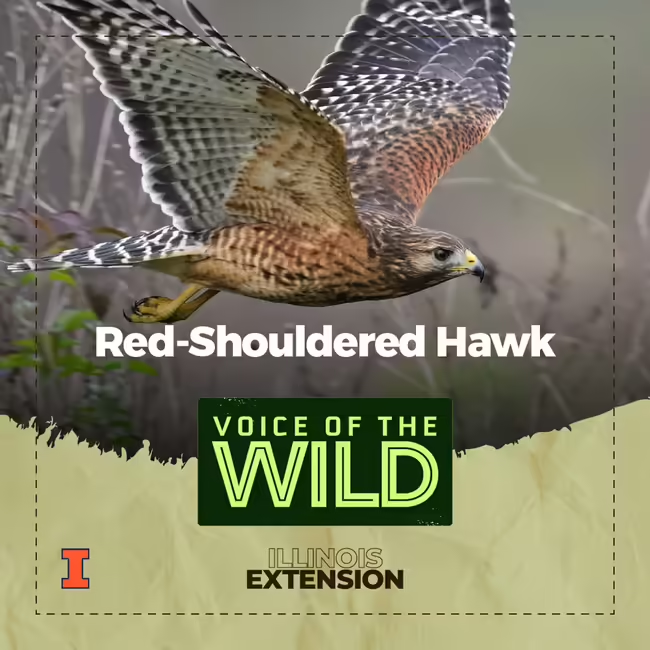
Episode Number
41
Episode Show Notes / Description
Red-shouldered hawk (Buteo lineatus).
An agile forest “buteo” with handsome plumage.
Do you want to learn more bird songs, frog calls, and insect noises? Join Voice of the Wild every Friday to explore a new wild voice. We’re available on most podcast platforms, including Apple Podcasts, Spotify, and YouTube.
Subscription links Here
Subscribe to the Newsletter
Listen online on our Homepage
The following Cornell Lab | Macaulay Library recordings were used in this episode:
- Red-shouldered hawk song by William W. H. Gunn (ML505989)
- Red-shouldered hawk first call by Gerrit Vyn (ML505992)
- Red-shouldered hawk second call by Wil Hershberger (ML505997)
The following Xeno-Canto recordings were used in this episode:
- Blue Jay mimic call by Christopher McPherson (XC600534)
Sources and more:
- Christopher McPherson, XC600534. Accessible at www.xeno-canto.org/60053
- https://www.allaboutbirds.org/guide/Red-shouldered_Hawk
- https://www.audubon.org/field-guide/bird/red-shouldered-hawk
- Dobson C, Kassenbaum D, Oehmke D, et al. 2023. Field guide to hotspots and birds in Illinois. Champaign-Urbana: Scissortail LLC.
- Dunne P, Sibley D, Sutton C. 2012. Hawks in flight : the flight identification of North American raptors. 2nd ed. Boston: Houghton Mifflin Harcourt.
- National Audubon Society videoguide to the birds of North America. 2004. Fullscreen. Carrboro, NC: Godfrey-Stadin Productions.
- Sibley D. 2016. Sibley birds East : field guide to birds of eastern North America. Second edition. New York: Alfred A. Knopf (Field guide to birds of eastern North America).
Transcript
This is Illinois Extension’s Voice of the Wild. A new wild voice in just a moment, so find someplace quiet, take a deep breath, and enjoy.
This slim hawk is more nimble than the red-tailed hawk; An adaptation that makes the bird well suited for navigating the forested riverside ecosystems it prefers.
In winter they’ll often perch low and at the edge of these forests where they can keep an eye out for tasty small rodents and perhaps even small birds. In the warm seasons when they can hunt through the green of the riverside forest, they’re not above taking a frog, insect, or crawfish.
Bold and handsomely marked, its chest and shoulders are a mottled ochre red. Its wings are a checkerboard of black and white. In flight the tail is strongly and narrowly banded while the tips of the wings have translucent patches where light from above can be seen from below.
This is the red-shouldered hawk (Buteo lineatus) from the hawk family Accipitridae
The red shouldered hawks repeating call ranges in harshness from a forceful announcement to barely a squeak. Be careful IDing this hawk by its call alone; you’ll understand why after boldly proclaiming you’ve just heard a red shouldered, only to discover, for the fifth or sixth time, that you’ve been fooled again by a mischievous blue jay mimicking its call.
Here’s the actual hawk:
Thank you to the Macaulay library at the Cornell lab for our hawk sounds and to christopher McPHerson at xeno-canto.org for the blue jay mimic call. And thank you for tuning in to learn a new wild voice with Illinois Extension.
This slim hawk is more nimble than the red-tailed hawk; An adaptation that makes the bird well suited for navigating the forested riverside ecosystems it prefers.
In winter they’ll often perch low and at the edge of these forests where they can keep an eye out for tasty small rodents and perhaps even small birds. In the warm seasons when they can hunt through the green of the riverside forest, they’re not above taking a frog, insect, or crawfish.
Bold and handsomely marked, its chest and shoulders are a mottled ochre red. Its wings are a checkerboard of black and white. In flight the tail is strongly and narrowly banded while the tips of the wings have translucent patches where light from above can be seen from below.
This is the red-shouldered hawk (Buteo lineatus) from the hawk family Accipitridae
The red shouldered hawks repeating call ranges in harshness from a forceful announcement to barely a squeak. Be careful IDing this hawk by its call alone; you’ll understand why after boldly proclaiming you’ve just heard a red shouldered, only to discover, for the fifth or sixth time, that you’ve been fooled again by a mischievous blue jay mimicking its call.
Here’s the actual hawk:
Thank you to the Macaulay library at the Cornell lab for our hawk sounds and to christopher McPHerson at xeno-canto.org for the blue jay mimic call. And thank you for tuning in to learn a new wild voice with Illinois Extension.